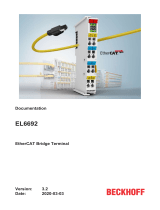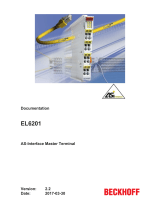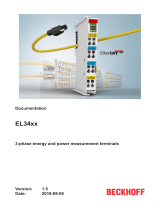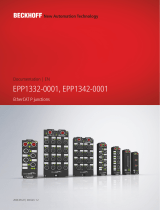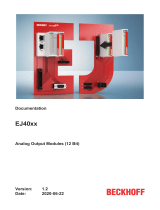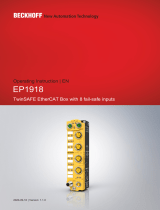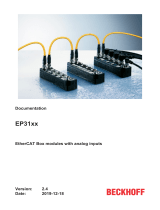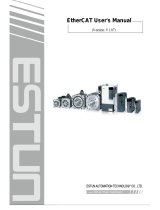
Documentation
EP7211
Servomotor module with OCT
1.0
2019-08-01
Version:
Date:


Table of contents
EP7211 3Version: 1.0
Table of contents
1 Foreword ....................................................................................................................................................5
1.1 Notes on the documentation..............................................................................................................5
1.2 Safety instructions .............................................................................................................................6
1.3 Documentation issue status ..............................................................................................................7
2 Product overview.......................................................................................................................................8
2.1 EtherCAT Box - Introduction..............................................................................................................8
2.2 EP7211-x034 - Introduction.............................................................................................................10
2.3 Technical data .................................................................................................................................11
2.4 Scope of supply ...............................................................................................................................12
2.5 Technology ......................................................................................................................................13
3 Mounting and cabling..............................................................................................................................15
3.1 Mounting .........................................................................................................................................15
3.1.1 Dimensions ...................................................................................................................... 15
3.1.2 Fixing ............................................................................................................................... 16
3.1.3 Functional earth (FE) ....................................................................................................... 16
3.2 Cabling ............................................................................................................................................17
3.2.1 Power supply ................................................................................................................... 18
3.2.2 EtherCAT ......................................................................................................................... 20
3.2.3 Motor, brake and feedback system.................................................................................. 22
3.2.4 Hardware Enable / Safe Torque Off ................................................................................ 24
3.2.5 Touch Probe .................................................................................................................... 27
4 Commissioning........................................................................................................................................29
4.1 Activate motor output stage.............................................................................................................29
4.2 Configuration in TwinCAT................................................................................................................29
4.3 Start-up and parameter configuration..............................................................................................30
4.3.1 Integration into the NC configuration ............................................................................... 30
4.3.2 Settings with the Drive Manager...................................................................................... 34
4.3.3 Settings in the CoE register ............................................................................................. 39
4.3.4 NC settings ...................................................................................................................... 42
4.3.5 Commissioning without NC, status word/control word..................................................... 48
4.3.6 Settings for the automatic configuration .......................................................................... 51
4.3.7 Configure end position monitoring ................................................................................... 53
4.3.8 Homing ............................................................................................................................ 54
4.3.9 Touch Probe .................................................................................................................... 57
4.4 Drive profiles....................................................................................................................................61
4.5 Operation modes .............................................................................................................................62
4.5.1 Overview.......................................................................................................................... 62
4.5.2 CSV ................................................................................................................................. 63
4.5.3 CST.................................................................................................................................. 66
4.5.4 CSTCA............................................................................................................................. 69
4.5.5 CSP ................................................................................................................................. 72
4.6 Process data MDP 742....................................................................................................................76
4.7 DS402 process data ........................................................................................................................80

Table of contents
EP72114 Version: 1.0
4.8 Object description (MDP 742) .........................................................................................................84
4.8.1 Restore object.................................................................................................................. 84
4.8.2 Configuration data ........................................................................................................... 84
4.8.3 Configuration data (vendor-specific)................................................................................ 91
4.8.4 Command object.............................................................................................................. 91
4.8.5 Input data......................................................................................................................... 91
4.8.6 Output data ...................................................................................................................... 93
4.8.7 Information / diagnosis data............................................................................................. 95
4.8.8 Standard objects.............................................................................................................. 98
4.9 Object description (DS402) ...........................................................................................................107
4.9.1 Configuration data ......................................................................................................... 108
4.9.2 Configuration data (vendor-specific).............................................................................. 113
4.9.3 Command object ........................................................................................................... 113
4.9.4 Input/output data............................................................................................................ 114
4.9.5 Information / diagnosis data .......................................................................................... 119
4.9.6 Standard objects............................................................................................................ 122
5 Appendix ................................................................................................................................................129
5.1 General operating conditions.........................................................................................................129
5.2 Firmware Update EL/ES/EM/ELM/EPxxxx ....................................................................................130
5.2.1 Device description ESI file/XML..................................................................................... 131
5.2.2 Firmware explanation .................................................................................................... 134
5.2.3 Updating controller firmware *.efw................................................................................. 135
5.2.4 FPGA firmware *.rbf....................................................................................................... 136
5.2.5 Simultaneous updating of several EtherCAT devices.................................................... 140
5.3 EtherCAT Box- / EtherCATPBox - Accessories ..........................................................................141
5.4 Servo technology - accessories.....................................................................................................141
5.5 General note on the introduction of the Beckhoff Identification Code (BIC) ..................................142
5.6 Support and Service ......................................................................................................................144

Foreword
EP7211 5Version: 1.0
1 Foreword
1.1 Notes on the documentation
Intended audience
This description is only intended for the use of trained specialists in control and automation engineering who
are familiar with the applicable national standards.
It is essential that the documentation and the following notes and explanations are followed when installing
and commissioning these components.
It is the duty of the technical personnel to use the documentation published at the respective time of each
installation and commissioning.
The responsible staff must ensure that the application or use of the products described satisfy all the
requirements for safety, including all the relevant laws, regulations, guidelines and standards.
Disclaimer
The documentation has been prepared with care. The products described are, however, constantly under
development.
We reserve the right to revise and change the documentation at any time and without prior announcement.
No claims for the modification of products that have already been supplied may be made on the basis of the
data, diagrams and descriptions in this documentation.
Trademarks
Beckhoff
®
, TwinCAT
®
, EtherCAT
®
, EtherCATG
®
, EtherCATG10
®
, EtherCATP
®
, SafetyoverEtherCAT
®
,
TwinSAFE
®
, XFC
®
, XTS
®
and XPlanar
®
are registered trademarks of and licensed by Beckhoff Automation
GmbH. Other designations used in this publication may be trademarks whose use by third parties for their
own purposes could violate the rights of the owners.
Patent Pending
The EtherCAT Technology is covered, including but not limited to the following patent applications and
patents: EP1590927, EP1789857, EP1456722, EP2137893, DE102015105702 with corresponding
applications or registrations in various other countries.
EtherCAT
®
is registered trademark and patented technology, licensed by Beckhoff Automation GmbH,
Germany.
Copyright
© Beckhoff Automation GmbH & Co. KG, Germany.
The reproduction, distribution and utilization of this document as well as the communication of its contents to
others without express authorization are prohibited.
Offenders will be held liable for the payment of damages. All rights reserved in the event of the grant of a
patent, utility model or design.

Foreword
EP72116 Version: 1.0
1.2 Safety instructions
Safety regulations
Please note the following safety instructions and explanations!
Product-specific safety instructions can be found on following pages or in the areas mounting, wiring,
commissioning etc.
Exclusion of liability
All the components are supplied in particular hardware and software configurations appropriate for the
application. Modifications to hardware or software configurations other than those described in the
documentation are not permitted, and nullify the liability of Beckhoff Automation GmbH & Co. KG.
Personnel qualification
This description is only intended for trained specialists in control, automation and drive engineering who are
familiar with the applicable national standards.
Description of instructions
In this documentation the following instructions are used.
These instructions must be read carefully and followed without fail!
DANGER
Serious risk of injury!
Failure to follow this safety instruction directly endangers the life and health of persons.
WARNING
Risk of injury!
Failure to follow this safety instruction endangers the life and health of persons.
CAUTION
Personal injuries!
Failure to follow this safety instruction can lead to injuries to persons.
NOTE
Damage to environment/equipment or data loss
Failure to follow this instruction can lead to environmental damage, equipment damage or data loss.
Tip or pointer
This symbol indicates information that contributes to better understanding.

Foreword
EP7211 7Version: 1.0
1.3 Documentation issue status
Version Comment
1.0 • First release
0.4 • Preliminary version
0.3 • Updates
0.2 • Technical data updated
0.1 • First draft
Firmware and hardware versions
This documentation refers to the firmware and hardware version that was applicable at the time the
documentation was written.
The module features are continuously improved and developed further. Modules having earlier production
statuses cannot have the same properties as modules with the latest status. However, existing properties
are retained and are not changed, so that older modules can always be replaced with new ones.
The firmware and hardware version (delivery state) can be found in the batch number (D-number) printed on
the side of the EtherCATBox.
Syntax of the batch number (D-number)
D: WW YY FF HH
WW - week of production (calendar week)
YY - year of production
FF - firmware version
HH - hardware version
Example with D no. 29 10 02 01:
29 - week of production 29
10 - year of production 2010
02 - firmware version 02
01 - hardware version 01
Beckhoff Identification Code (BIC)
The Beckhoff Identification Code contains additional information about the delivery state of the module:
General note on the introduction of the Beckhoff Identification Code (BIC) [}142].

Product overview
EP72118 Version: 1.0
2 Product overview
2.1 EtherCAT Box - Introduction
The EtherCAT system has been extended with EtherCAT Box modules with protection class IP67. Through
the integrated EtherCAT interface the modules can be connected directly to an EtherCAT network without an
additional Coupler Box. The high-performance of EtherCAT is thus maintained into each module.
The extremely low dimensions of only 126x30x26.5 mm (hxw xd) are identical to those of the Fieldbus
Box extension modules. They are thus particularly suitable for use where space is at a premium. The small
mass of the EtherCAT modules facilitates applications with mobile I/O interface (e.g. on a robot arm). The
EtherCAT connection is established via screened M8connectors.
Fig.1: EtherCAT Box Modules within an EtherCAT network
The robust design of the EtherCAT Box modules enables them to be used directly at the machine. Control
cabinets and terminal boxes are now no longer required. The modules are fully sealed and therefore ideally
prepared for wet, dirty or dusty conditions.
Pre-assembled cables significantly simplify EtherCAT and signal wiring. Very few wiring errors are made, so
that commissioning is optimized. In addition to pre-assembled EtherCAT, power and sensor cables, field-
configurable connectors and cables are available for maximum flexibility. Depending on the application, the
sensors and actuators are connected through M8 or M12connectors.
The EtherCAT modules cover the typical range of requirements for I/O signals with protection class IP67:
• digital inputs with different filters (3.0ms or 10μs)
• digital outputs with 0.5 or 2A output current
• analog inputs and outputs with 16bit resolution
• Thermocouple and RTD inputs
• Stepper motor modules
XFC (eXtreme Fast Control Technology) modules, including inputs with time stamp, are also available.

Product overview
EP7211 9Version: 1.0
Fig.2: EtherCAT Box with M8 connections for sensors/actuators
Fig.3: EtherCAT Box with M12 connections for sensors/actuators
Basic EtherCAT documentation
You will find a detailed description of the EtherCAT system in the Basic System Documentation for
EtherCAT, which is available for download from our website (www.beckhoff.com) under Downloads.
EtherCAT XML Device Description
You will find XML files (XML Device Description Files) for Beckhoff EtherCAT modules on our web-
site (www.beckhoff.com) under Downloads, in the Configuration Files area.

Product overview
EP721110 Version: 1.0
2.2 EP7211-x034 - Introduction
Fig.4: EP7211-9034
The EP7211-x034 EtherCAT Box is a single-channel servo drive for synchronous servomotors with OCT
feedback system.
It is intended for operation with motors from the AM81xx series. These motors have an electronic
identification plate. EP7211-x034 can read the electronic identification plate in order to set the motor
parameters in TwinCAT automatically.
The EP7211-9034 variant supports the "Safe Torque Off" (STO) function. This variant is non-reactive and
can be used in a safety application.
Process-side interfaces of EP7211-x034:
• Motor
• Motor brake
• OCT communication:
◦ Feedback
◦ Electronic identification plate readout
• 2 x touch probe
• Hardware Enable (EP7211-0034): digital input for activating the output stage
• Safe Torque Off (EP7211-9034)
The motor is connected via a hybrid cable. The hybrid cable contains the wires for the motor phases, the
brake and the OCT communication.
EP7211-x034 can be controlled via the MDP742 or alternatively the DS402 drive profile.

Product overview
EP7211 11Version: 1.0
2.3 Technical data
Technical data EP7211-0034 EP7211-9034
Fieldbus
Fieldbus EtherCAT
Connection 2 x M8 socket (green)
Electrical isolation 500V (fieldbus / IO)
Distributed Clocks
Yes
Process image
Dependent on the operation mode [}62]
Supply
Connection
Feed: 1 x 7/8" plug, 5-pin [}18]
Downstream connection: 1 x 7/8" socket, 5-pin [}18]
Control voltage U
S
24V
DC
(-15% / +20%)
DC link supply voltage U
P
48V
DC
(8 - 50V
DC
), not protected against polarity reversal
Supply of the module electronics from the control voltage U
S
Current consumption of the module
electronics
typ. 120mA
Current consumption from the
DC link supply voltage
typ. 50mA
Motor
Motor type Synchronous servomotor
Connection
1 x iTec socket, 9-pin, M23 [}22]
Hybrid connector for:
• 1 x motor
• 1 x feedback (OCT encoder)
• 1 x brake
Power rating P
n
max. 276W
Nominal output current I
n
4.5A
rms
Peak output current I
peak
9.0A
rms
for 1s
Output frequency range 0..599Hz
PWM clock frequency 16kHz
Current controller frequency 32kHz
Speed controller frequency 16kHz
Drive profile [}61]
Alternatively:
• MDP 742 (default)
• CiA DS402
Motor brake
Output voltage 24V
DC
from the control voltage U
S
Output current max. 0.5A, short-circuit protected
Digital inputs
Interfaces 2 x touch probe
1 x Hardware Enable
2 x touch probe
1 x Safe Torque Off (STO)

Product overview
EP721112 Version: 1.0
Technical data EP7211-0034 EP7211-9034
Environmental conditions
Permissible ambient temperature
during operation
-25°C ... +60°C
Permissible ambient temperature
during storage
-40°C ... +85°C
Vibration/ shock resistance conforms to EN60068-2-6/ EN60068-2-27
EMC immunity/emission conforms to EN61000-6-2/ EN61000-6-4
EMC category Category C3 (auxiliary filter required)
Category C2, C1 in preparation (auxiliary filter required)
Protection class IP65, IP66, IP67 (conforms to EN 60529)
Mechanics
Dimensions 150mmx 60mmx 26.5mm (without plug connectors)
Weight approx.500g
Installation position variable
Approvals and conformity
Approvals CE, UL in preparation
2.4 Scope of supply
Make sure that the following components are included in the scope of delivery:
• 1x EtherCAT Box EP7211-0034 / EP7211-9034
• 2x protective caps for EtherCAT socket (mounted)
• 1x protective cap for 7/8" socket (mounted)
• 10X labels, blank (1 strip of 10)

Product overview
EP7211 13Version: 1.0
2.5 Technology
Servomotor
The servomotor is an electrical motor. Together with a servo drive the servomotor forms a drive. The
servomotor is operated in a closed control loop with position, torque or speed control.
EP7211-x034 supports control of permanent magnet synchronous motors. These consist of 3 coils which are
offset by 120° and a permanent magnet rotor.
Fig.5: Three synchronous motor coils, each offset by 120°
One Cable Technology (OCT)
In the servomotors from the AM8100-xF2 x series the feedback signals are transmitted directly via the power
supply cable, so that power and feedback system are combined in a single motor connection cable. With the
use of the One Cable technology, the information is sent reliably and without interference through a digital
interface. Since a cable and plug are omitted at both the motor and controller end, the component and
commissioning costs are reduced.
Thermal I²T motor model
The thermal I²T motor model represents the thermal behavior of the motor winding taking into account the
absolute thermal resistance R
th
and the thermal capacity C
th
of motor and the stator winding.
The model assumes that the motor reaches its maximum continuous operating temperature T
nom
during
continuous operation with rated current I
nom
. This temperature corresponds to 100% motor load. During
operation at rated current the motor model reaches a load of 63% after a time of τ
th
=R
th
∙C
th
and slowly
reaches its continuous operating temperature.
If the motor is operated with a current that is greater than the rated current, the model reaches 100% load
more quickly.
If the load of the I²T model exceeds 100%, the requested set current is limited to the rated current, in order to
protect the motor winding thermally. The load reduces to a maximum of 100%. If the current falls below the
rated current, the load falls below 100% and the set current limitation is cancelled.
For a motor that has been cooled to ambient temperature, the time for reaching 100% load with a set current
that exceeds the rated current can be estimated with τ
th
∙I
nom
²/I
actual
².
The actual load must be known for exact calculation of the time when the 100% load threshold is exceeded.

Product overview
EP721114 Version: 1.0
Fig.6: Limitation to the rated motor current

Mounting and cabling
EP7211 15Version: 1.0
3 Mounting and cabling
3.1 Mounting
3.1.1 Dimensions
150
60
141
Ø 4.5
Fig.7: Dimensions
All dimensions are given in millimeters.
Housing features
Housing material PA6 (polyamide)
Sealing compound polyurethane
Mounting two fastening holes Ø4.5mm for M4
Metal parts brass, nickel-plated
Contacts CuZn, gold-plated
Power feed through max. 16A at 40°C (according to IEC 60512-3)
Mounting position variable
Protection class IP65, IP66, IP67 (conforms to EN60529) when screwed together
Dimensions (HxWxD) approx. 150 x 60 x 26.5mm (without connectors)

Mounting and cabling
EP721116 Version: 1.0
3.1.2 Fixing
NOTE
Protect connectors against soiling!
Protection class IP67 can only be guaranteed if all cables and connectors are connected.
Protect the connections against soiling during mounting.
Mount the module with two M4 screws in the centrally located fastening holes.
The bolts must be longer than 15mm. The fastening holes in the modules have no thread.
Note when mounting that the overall height is increased further by the fieldbus connections. See chapter
Accessories.
3.1.3 Functional earth (FE)
All existing connections for the functional earth must be connected to earth:
• Fastening holes
• "FE" cores in the supply cables
Functional earth via the fastening holes
The fastening holes [}16] also serve as connections for the functional earth (FE).
Make sure that the box is earthed with low impedance via both fastening screws.
FE
FE
Fig.8: Functional earth via the fastening holes
Functional earth via the supply lines
The pins of the supply connectors [}18] marked with "FE" are directly connected to the functional earth
potential of the fastening holes.
Connect the functional earth of the "FE" cores in accordance with the following instructions:
• If the remote station is a device with a 7/8" connector: connect the devices with a pre-configured cable.
Possible types of preconfigured cables:
◦ Beckhoff ZK2030-1112-0xxx
◦ Beckhoff ZK2030-1114-0xxx
◦ Beckhoff ZK2030-1314-0xxx
• Otherwise: Earth the "FE" core with low impedance as near as possible to the remote station.

Mounting and cabling
EP7211 17Version: 1.0
3.2 Cabling
X60 X61
X20
X04
X03
X02
X01
X40 X41
Fig.9: Connector overview
Name Connector
type
Tightening
torque
Function
X01 M12 0.6Nm
1)
Hardware Enable / Safe Torque Off [}24]
X02
X03 M12 0.6Nm
1)
Touch Probe [}27]
X04
X20 iTec M23 -
Motor, brake and feedback system [}22]
X40 M8 0.4Nm
1)
EtherCAT [}20]
X41
X60 7/8" 1.5Nm
Power supply [}18]
X61
1)
Mount connectors on these plug connectors using a torque wrench, e.g. ZB8801 from Beckhoff.

Mounting and cabling
EP721118 Version: 1.0
3.2.1 Power supply
3.2.1.1 Connection
Two 7/8" connectors at the low-end of the modules are used for feeding and routing the supply voltages:
• "IN" (male): left connector for feeding the supply voltages
• "OUT" (female): right connector for downstream connection
1
2
3
4
5
IN
5
4
3
2
1
OUT
Fig.10: 7/8" connector pin assignment
NoteDefect possible through polarity reversal. The input for the DC link voltage Up is not protected
against polarity reversal. Ensure that the polarity is correct.
Pin Name Comment Core colors
1)
1 GND
P
GND to U
P
Black
2 GND
S
GND to U
S
Blue
3 FE Functional earth Grey
4 +24 V
DC
U
S
Control voltage U
S
Brown
5 +48 V
DC
U
P
DC link voltage U
P
White
1)
The core colors apply to cables of the type: Beckhoff ZK203x-xxxx.

Mounting and cabling
EP7211 19Version: 1.0
3.2.1.2 Status LEDs
The status of the supply voltages is signaled by two LEDs. A Status LED lights up green when the respective
supply voltage is present on the connector for the supply.
Fig.11: Power supply Status LEDs
3.2.1.3 Conductor losses
Take into account the voltage drop on the supply line when planning a system. Avoid the voltage drop being
so high that the supply voltage at the box lies below the minimum permissible value. See Technical data.
Variations in the voltage of the power supply unit must also be taken into account.
The following graph illustrates the dependence of the voltage drop on the core cross-section, current and
cable length:
Fig.12: Losses on the supply line

Mounting and cabling
EP721120 Version: 1.0
3.2.2 EtherCAT
3.2.2.1 Connection
EtherCAT Boxes (EPxxxx) have two green M8 sockets for the incoming and outgoing EtherCAT
connections.
Fig.13: EtherCAT connection
Fig.14: M8 socket pin assignment
Assignment
There are various different standards for the assignment and colors of connectors and cables for EtherCAT.
EtherCAT Plug connector Cable Standard
Signal M8 M12 RJ45
1
ZB9010, ZB9020,
ZB9030, ZB9032,
ZK1090-6292,
ZK1090-3xxx-xxxx
ZB9031 and old ver-
sions of ZB9030,
ZB9032,
ZK1090-3xxx-xxxx
TIA-568B
Tx + Pin 1 Pin 1 Pin 1 yellow
2
orange/white
3
white/orange
Tx - Pin 4 Pin 3 Pin 2 orange
2
orange
3
orange
Rx + Pin 2 Pin 2 Pin 3 white
2
blue/white
3
white/green
Rx - Pin 3 Pin 4 Pin 6 blue
2
blue
3
green
Shield Housing Shroud Shield Shield Shield
1
) colored markings according to EN 61918 in the four-pin RJ45 connector ZS1090-0003
2
) wire colors according to EN 61918
3
) wire colors
Assimilation of color coding for cable ZB9030, ZB9032 and ZK1090-3xxxx-xxxx (with
M8 connectors)
For unification, the prevalent cables ZB9030, ZB9032 and ZK1090-3xxx-xxxx were changed to the
colors of EN61918 (yellow, orange, white, blue). So different color coding exists. But the electrical
properties are absolutely identical.
Page is loading ...
Page is loading ...
Page is loading ...
Page is loading ...
Page is loading ...
Page is loading ...
Page is loading ...
Page is loading ...
Page is loading ...
Page is loading ...
Page is loading ...
Page is loading ...
Page is loading ...
Page is loading ...
Page is loading ...
Page is loading ...
Page is loading ...
Page is loading ...
Page is loading ...
Page is loading ...
Page is loading ...
Page is loading ...
Page is loading ...
Page is loading ...
Page is loading ...
Page is loading ...
Page is loading ...
Page is loading ...
Page is loading ...
Page is loading ...
Page is loading ...
Page is loading ...
Page is loading ...
Page is loading ...
Page is loading ...
Page is loading ...
Page is loading ...
Page is loading ...
Page is loading ...
Page is loading ...
Page is loading ...
Page is loading ...
Page is loading ...
Page is loading ...
Page is loading ...
Page is loading ...
Page is loading ...
Page is loading ...
Page is loading ...
Page is loading ...
Page is loading ...
Page is loading ...
Page is loading ...
Page is loading ...
Page is loading ...
Page is loading ...
Page is loading ...
Page is loading ...
Page is loading ...
Page is loading ...
Page is loading ...
Page is loading ...
Page is loading ...
Page is loading ...
Page is loading ...
Page is loading ...
Page is loading ...
Page is loading ...
Page is loading ...
Page is loading ...
Page is loading ...
Page is loading ...
Page is loading ...
Page is loading ...
Page is loading ...
Page is loading ...
Page is loading ...
Page is loading ...
Page is loading ...
Page is loading ...
Page is loading ...
Page is loading ...
Page is loading ...
Page is loading ...
Page is loading ...
Page is loading ...
Page is loading ...
Page is loading ...
Page is loading ...
Page is loading ...
Page is loading ...
Page is loading ...
Page is loading ...
Page is loading ...
Page is loading ...
Page is loading ...
Page is loading ...
Page is loading ...
Page is loading ...
Page is loading ...
Page is loading ...
Page is loading ...
Page is loading ...
Page is loading ...
Page is loading ...
Page is loading ...
Page is loading ...
Page is loading ...
Page is loading ...
Page is loading ...
Page is loading ...
Page is loading ...
Page is loading ...
Page is loading ...
Page is loading ...
Page is loading ...
Page is loading ...
Page is loading ...
Page is loading ...
Page is loading ...
Page is loading ...
Page is loading ...
Page is loading ...
Page is loading ...
Page is loading ...
Page is loading ...
Page is loading ...
/
